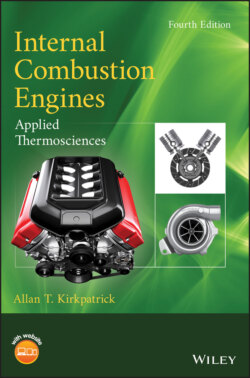Читать книгу Internal Combustion Engines - Allan T. Kirkpatrick - Страница 55
2.7 Ideal Four‐Stroke Process and Residual Fraction
ОглавлениеThe simple gas cycle models assume that the heat rejection process occurs at constant volume, and neglect the gas flow that occurs when the intake and exhaust valves are opened and closed. In this section, we use the energy equation to model the exhaust and intake strokes, and determine the residual fraction of gas remaining in the cylinder.
At this level of modeling, we need to make some assumptions about the operation of the intake and exhaust valves. During the exhaust stroke, the exhaust valve is assumed to open instantaneously at bottom dead center and close instantaneously at top dead center. Similarly, during the intake stroke, the intake valve is assumed to open at top dead center and remain open until bottom dead center. The intake and exhaust valve overlap, that is, the time during which they are open simultaneously, is therefore assumed to be zero.
The intake and exhaust strokes are also assumed to occur adiabatically and at constant pressure. Constant pressure intake and exhaust processes occur only at low engine speeds. More realistic computations model the instantaneous pressure drop across the valves and furthermore would account for the heat transfer, which is especially significant during the exhaust. Such considerations are deferred to Chapters 5 and 9.
Referring to Figure 2.10, the ideal intake and exhaust processes are as follows:
| 4 to 5a | Constant cylinder volume blowdown |
| 5a to 6 | Constant pressure exhaustion |
| 6 to 7 | Constant cylinder volume reversion |
| 7 to 1 | Constant pressure induction |
Figure 2.10 Four‐stroke inlet and exhaust flow. inlet pressure, exhaust pressure.
